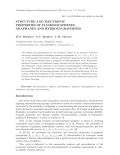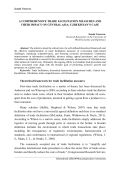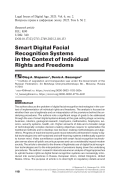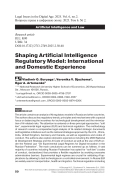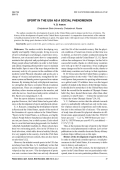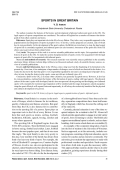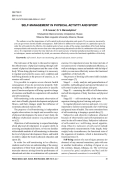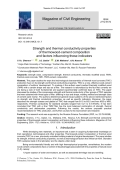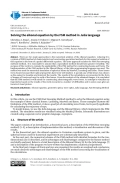The analysis and generalization of the calculation results of the structure, electronic and energy characteristics of graphene monolayer polymorphs L6, L4-8, L3-12, L4-6-12, L5-7 functionalized with fluorine, hydrogen and hydroxyl group atoms has been carried out. It has been established that in graphanes and fluorographenes, as the deformation parameter increases, the sublimation energy decreases and the lattice constant increases. The sublimation energy decreases in the sequence: hydroxygraphenes, fluorographenes, graphanes. The studied materials have a band gap ranging from 1.93 to 6.46 eV. It has been established that the band gap decreases with increase of sublimation energy. With an increase of the electronegativity of the attached atoms (groups), the sublimation energy increases, and the band gap decreases. Graphanes have the lowest sublimation energy and the largest band gap.
Maqola aniq belgilangan nazariy asosning muhim roli va savdo bilan bog’liq muammolarni bartaraf etish, raqobatbardoshlikni oshirish va iqtisodiy rivojlanishni rivojlantirishda savdoni osonlashtirish choralarini samarali amalga oshirish haqida. O’zbekiston va Markaziy Osiyodagi boshqa davlatlarning barqaror iqtisodiy taraqqiyoti uchun axborot bilan ta’minlanishning doimiy yaxshilanishi, ilgari surilgan qarorlar, apellyatsiya tartib-qoidalari va turli rasmiyatchiliklar muhim ahamiyat kasb etmoqda. Oxir oqibat, savdo tartib-qoidalarini soddalashtirish va tegishli xarajatlarni kamaytirish bo’yicha olib borilayotgan sa’y-harakatlar global miqyosda inklyuziv o’sish va farovonlikni rag’batlantirishning keng maqsadiga mos keladi.
The authors discuss the problem of digital facial recognition technologies in the context of implementation of individual rights and freedoms. The analysis is focused on whether their use is legitimate and on interpretation of the provisions behind the underlying procedures. The authors note a significant range of goals to be addressed through the use of smart digital systems already at the goal-setting stage: economy, business, robotics, geological research, biophysics, mathematics, biophysics, avionics, security systems, health, etc. Higher amounts of data and a broader range of technologically complex decision-making objectives require to systematize the traditional methods and to develop new decision-making methodologies and algorithms. Progress of machine learning and neural networks will transform today’s digital technologies into self-sustained and self-learning systems intellectually superior to human mind. Video surveillance coupled with smart facial recognition technologies serves above all public security purposes and can considerably impact modern society. The article is devoted to the theme of legitimate use of digital facial recognition technologies and to the interpretation of provisions laying down the underlying procedures. The authors’ research interests assume an analysis of legal approaches to uphold human rights as digital facial recognition systems are increasingly introduced into social practices in Russia, European Union, United Kingdom, United States, China. The purpose of article is to shed light on regulatory details around the use of AI systems for remote biometric identification of persons in the process of statutory regulation. Methods: formal logic, comparison, analysis, synthesis, correlation, generalization. Conclusions: the analysis confirms that facial recognition technologies are progressing considerably faster than their legal regulation. Deployment of such technologies make possible ongoing surveillance, a form of collecting information on private life of persons. It is noted that accounting for these factors requires amending the national law in order to define the status and the rules of procedure for such data, as well as the ways to inform natural persons that information associated with them is being processed.
The article contains an analysis of AI regulatory models in Russia and other countries. The authors discuss key regulatory trends, principles and mechanisms with a special focus on balancing the incentives for technological development and the minimization of AI-related risks. The attention is centered on three principal approaches: “soft law”, experimental legal regimes (ELR) and technical regulation. The methodology of research covers a comparative legal analysis of AI-related strategic documents and legislative initiatives such as the national strategies approved by the U. S., China, India, United Kingdom, Germany and Canada, as well as regulations and codes of conduct. The authors also explore domestic experience including the 2030 National AI Development Strategy and the AI Code of Conduct as well as the use of ELR under the Federal Law “On Experimental Legal Regimes for Digital Innovation in the Russian Federation”. The main conclusions can be summed up as follows. A vast majority of countries including Russian Federation has opted for “soft law” (codes of conduct, declarations) that provides a flexible regulation by avoiding excessive administrative barriers. Experimental legal regimes are crucial for validating AI applications by allowing to test technologies in a controlled environment. In Russia ELR are widely used in transportation, health and logistics. Technical regulation including standardization is helpful to foster security and confidence in AI. The article notes widespread development of national and international standards in this field. Special regulation (along the lines of the European Union AI Act) still has not become widespread. A draft law based on the risk-oriented approach is currently discussed in Russia. The authors of the article argue for the gradual, iterative development of legal framework for AI to avoid rigid regulatory barriers emerging too prematurely. They also note the importance of international cooperation and adaptation of the best practices to shape an efficient regulatory system.
The author considers the development of sports in the United States and its impact on the lives of citizens. The history of the development of sports in the United States is presented. A comparative characteristic of the attitude to health promotion in the USA and Russia is given. The paper deals with topical issues of the formation of useful practices for doing sports business in the United States.
The author examines the features of the history and development of physical culture and sports in the UK. The legal aspects of sports competitions are considered. The culture of England has a number of features that distinguish it from other countries and states. Relevance. Sport plays an important role in the life of every Briton. They take a very responsible approach to the popularization and integration of sports in people’s lives. To do this, various programs are created, each of which has its own peculiarity. In the development of the sports sphere, the British are in no hurry to stop, the legal aspect of sports life is constantly regulated, and informal sports are also invented. Awareness of the sports life of the UK allows you to get to know their culture better. Goal, tasks. The purpose of the work is to review scientific publications on this topic. Get acquainted with the history of sports in the UK. To study the system of popularization of sports events. Get acquainted with the legal aspects of sports life. Get acquainted with informal sports. Materials and methods of research. The research materials were scientific sources published in the scientific electronic library elibrary (website https://elibrary. ru). Research methods: study of scientific literary sources, review of scientific publications. Results and their discussion. Sport in the UK has come a long way from the beginning of its formation to the present day. Over time, it has undergone a large number of changes, most of which are directed for the better. As a result, this has led to the fact that sport is very responsibly regulated by law and is an integral part of people’s lives, who, in turn, having the desire to play sports, come up with new informal types of it. Conclusion. Sport in the UK, as in many other countries, has generally accepted norms. However, it also has its own peculiarities, starting from the history of the formation of sports, ending with legal aspects. The physical culture of the state is quite well developed, but this does not prevent it from growing and developing, new informal sports will constantly be invented, legal regulation will be clarified and the range of programs aimed at popularizing the sports lifestyle will expand, but most importantly, it will always be exclusively beneficial for the physical and cultural development of a person.
The authors reveal the importance of self-control in physical education and sports. If you exercise incorrectly, you can get severe chronic health consequences. Self-control is diff erent for each person or a particular sport. In order for self-control to be eff ective, the student needs to have an idea of the energy expenditure of his body during neuropsychiatric and muscular stresses that arise when performing educational activities in combination with systematic stress. It is important to know the time intervals of rest and recovery of mental and physical performance, as well as techniques, means and methods by which you can more eff ectively restore the functional capabilities of the body
The paper studies the ways that technological characteristics of thermal wood concrete (TWC) production have on its strength and thermal conductivity properties. TWC is a new, effective wood-cement composition of authors’ development. To produce it the authors used crushed thermally modified wood (TMW) with a certain shape and size as a filler. The research is rationalized by the fact that currently we are facing a lack of both fundamental and applied experimentally confirmed data on TWC. The paper discusses the studies of the compressive strength and thermal conductivity of four groups of TWC samples that were obtained with three types of filler, differing in size and shape, molding method and strength class of cement-sand mortar. The authors determined general impact patterns of the above-mentioned factors on strength and thermal conductivity properties, as well as specific indicators. Moreover, the paper describes the strength classes and grades of TWC that ranged from B1.5 to B3.5 and from M25 to M50, respectively. Thermal conductivity for standard samples ranged from 0.21 to 0.4 W/(mK). It has been concluded that TWC with a finer TMW filler has the most balanced combination of strength, thermal conductivity and deformation properties. Following the results, the authors proposed practical recommendations for TWC production, and further courses for its improvement and research.
There are two main approaches to the numerical solution of the eikonal equation: reducing it to a system of ODES (method of characteristics) and constructing specialized methods for the numerical solution of this equation in the form of a partial differential equation. The latter approach includes the FSM (Fast sweeping method) method. It is reasonable to assume that a specialized method should have greater versatility. The purpose of this work is to evaluate the applicability of the FSM method for constructing beams and fronts. The implementation of the FSM method in the Eikonal library of the Julia programming language was used. The method was used for numerical simulation of spherical lenses by Maxwell, Luneburg and Eaton. These lenses were chosen because their optical properties have been well studied. A special case of flat lenses was chosen as the easiest to visualize and interpret the results. The results of the calculations are presented in the form of images of fronts and rays for each of the lenses. From the analysis of the obtained images, it is concluded that the FSM method is well suited for constructing electromagnetic wave fronts. An attempt to visualize ray trajectories based on the results of his work encounters a number of difficulties and in some cases gives an incorrect visual picture.
In this paper, we study the effect of using the Metropolis–Hastings algorithm for sampling the integrand on the accuracy of calculating the value of the integral with the use of shallow neural network. In addition, a hybrid method for sampling the integrand is proposed, in which part of the training sample is generated by applying the Metropolis–Hastings algorithm, and the other part includes points of a uniform grid. Numerical experiments show that when integrating in high-dimensional domains, sampling of integrands both by the Metropolis–Hastings algorithm and by a hybrid method is more efficient with respect to the use of a uniform grid.
The article presents the results of the evaluation of quartiles of scientific conferences presented by leading rating agencies. The estimates are based on the use of three methods of multivariate statistical analysis: linear regression, discriminant analysis and neural networks. A training sample was used for evaluation, including the following factors: age and frequency of the conference, number of participants and number of reports, publication activity of the conference organizers, citation of reports. As a result of the study, the linear regression model confirmed the correctness of the quartiles exposed for 77% of conferences, while the methods of neural networks and discriminant analysis gave similar results, confirming the correctness of the quartiles exposed for 81 and 85% of conferences, respectively.
The problem of identifying deterministic cause-and-effect relationships, initially hidden in accumulated empirical data, is discussed. Statistical methods were used to identify such relationships. A simple mathematical model of cause-and-effect relationships is proposed, in the framework of which several models of causal dependencies in data are described – for the simplest relationship between cause and effect, for many effects of one cause, as well as for chains of cause-and-effect relationships (so-called transitive causes). Estimates are formulated that allow using the de Moivre–Laplace theorem to determine the parameters of causal dependencies linking events in a polynomial scheme trials. The statements about the unambiguous identification of causeandeffect dependencies that are reconstructed from accumulated data are proved. The possibilities of using such data analysis schemes in medical diagnostics and cybersecurity tasks are discussed.
